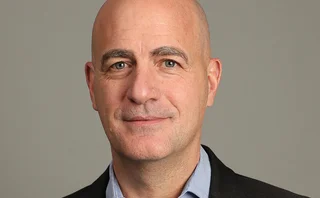
Equity derivatives house of the year - Société Générale
Plunging equity volatility in 2004 has proven a headache for major equity derivatives dealers. But French structured products stalwart Société Générale creatively turned the situation to its advantage

Implied equity volatility continued to tumble this year, with the Chicago Board of Trade’s S&P 500 Vix Index falling from 18.2 percentage points at the start of January to 12.3 by late December, compared with levels of more than 30 points in the first quarter of 2003. And this precipitous decline proved a major headache for all equity derivatives dealers.
Arguably, the impact was most noticeable for investment banks whose primary focus is geared to handling large vanilla volumes. This was because asset managers saw little reason to hedge downside equity exposures and hedge funds increasingly held on to cash as trading opportunities dried up. And the indication was that structured product houses offering yield enhancement strategies were likely to prove the relative winners during a fairly quiet period.
The large equity derivatives structurers, however, also faced severe problems, particularly given the climate of low interest rates around the world. So it appeared unlikely that many would post improved profits on 2003. And from a risk management standpoint, they also looked in trouble as their large warehoused correlation positions all exhibited negative vega at the start of the year, something that was exacerbated as volatility continued to decline.
These issues were particularly acute at Société Générale’s equity derivatives division. But through a combination of aggressive market trading activities, geographic expansion and strong innovation in structured products – particularly those related to hedge funds – the bank managed to reposition itself so that in the past few months it has become a net buyer of negative vega. And Lehman Brothers equity analysts Benoit Vicenzi and Cedric Durand-des-Aulois said in November that Société Générale’s equity derivatives revenues grew 9.9% year-on-year in the third quarter, 18% higher than their estimates.
But the route was far from easy. Rival dealers noted that Société Générale sold volatility in large volumes at the start of the year, something the bank admits. “In early 2004, our negative vega position and a market context of low volatility created a real concern for our trading books,” says Bernard Desforges, Société Générale’s Paris-based global head of equity derivatives sales and marketing. So the bank launched a programme to sell volatility heavily on the inter-dealer market. Société Générale’s heavy selling activities were noted at rival dealers, who believe the French bank sold up to $30 million of vega risk – equivalent to around $6 billion in notional.
After this initial sell-off, Société Générale became increasingly innovative in how it reduced its risks. And the development of a flow trading structure at the bank combined with its impressive development covering hedge funds proved critical. Innovations, such as the bank’s development of correlation swaps (Risk May 2004, page 46), where transaction sizes range from €250,000 to €1 million per correlation point and require the dealer to structure bespoke baskets of 10 to 35 individual names where it had significant correlation risk, helped to significantly reduce its risk exposures, or ‘book axe’, and provide clients with new trading opportunities.
“Société Générale has been the first to present and trade products like equity correlation swaps and options on hedge fund volatility,” says Pavandeep Sethi, global head of volatility trading at Citadel Group in Chicago. “It has managed to effectively look at its inventory of positions resulting from its structured product positions activity and use this to put together products that provide clients with an attractive risk/return profile,” Sethi adds. The French bank transacted similar trades with more than 19 leading hedge funds and other money managers this year, with transaction notionals exceeding $1 billion, says Société Générale.
But the other critical component in managing its risk stemmed directly from its structured products business – which itself faced significant challenges due to a tough trading environment, regulatory challenges in large markets such as Italy and a shift from equity to fixed-income products in the large Benelux market. But Société Générale managed to hold revenues steady in this particular area while repositioning its book axe.
It achieved this by offering vega-positive products and reducing the negative vega components in some of its more traditional offerings. For example, it approached its life insurance arm Sogecap, which manages a portfolio of €30 billion, to lay off some of its vega positions by structuring a deal that no other provider could offer, according to Pierre Bismuth, Sogecap’s Paris-based asset allocation manager.
Unlike many life insurers in Europe, which have scrambled to reduce their equity concentrations in the past two years, Sogecap needed to enhance its asset allocation to equity markets. What was unique about Société Générale’s approach was its ability to fix the level of volatility, smile and interest rate for the duration of Sogecap’s investment programme. Sogecap bought a 12-year capital-guaranteed structure based on the performance of a weighted-index stock index basket – 50% Eurostoxx 50, 30% S&P 500 and 20% Nikkei 225. “We are not an easy client,” Bismuth tells Risk. “No other bank was able to fix the volatility level for the entire duration of the programme.”
Sogecap started its programme in the second quarter of the year and has completed four instalments valued at €30 million each. Bismuth says the success of the transactions means the life insurer is likely to conduct similar investments this year.
EFG Mutual Fund Management, the fund management arm of one of Greece’s largest retail banks, EFG, also conducted vega-positve transactions with Société Générale, which had structured two funds for EFG’s retail customers, Kili Select Formula 1 and Kili Select Formula II, in 2003. As volatility levels dropped in 2004, Société Générale approached EFG to offer vega-positive products. EFG asked the French bank to structure two 10-year Emerald products with capital guarantees ranging between 125% and 130%. EFG sold $300 million of these products in 2004.
But it was also important for Société Générale to continue to offer vega-negative products. “To keep negative vega products as part of our offering, we introduced some features to reduce their negative vega,” says Desforges. For example, the bank introduced a lookback call – a positive vega product – to its second target return product offered in Hong Kong.
Société Générale’s Trigger Guaranteed Fund, sold via Hong Kong-based distributors such as HSBC, raised $1.2 billion in 2004. Catherine Cheung, a Hong Kong-based senior manager in the integrated financial services unit of HSBC, says the products were attractive to retail investors that felt constrained by the low interest rate environment.
The Trigger Guaranteed Fund structure offered a capital guarantee either on maturity date or in the event of early termination. Investors received a guaranteed 10% coupon during the first year, followed by 10% less 50% of the average under-performance of the six worst-performing stocks within a basket of 24 stocks, with the coupon floored at zero. Should the sum of the coupon returns hit 20% or more during a maturity period from two years to 10 years, the fund is redeemed. “The structure generated good interest and made good use of the yield curve,” says Cheung. “This was the first time such a structure has been sold in Hong Kong,” she adds.
The French bank also introduced so-called ‘ClickOblig’ products that turn equity correlation products into high-coupon bonds when markets perform over a trigger level. The bank sold $600 million of ClickOblig products in Europe this year.
“After our first cut in our vega position in early 2004, the alternative risk transfer products and a balanced offer of negative vega and positive vega products resulted in a stable position with limited interbank transaction costs,” says Société Générale’s Desforges. “At the end of 2004, our risks in correlation and volatility decreased by 50%, while our exotic trading book’s profit and loss remained positive despite low volatility.”
But Société Générale achieved much more than just effectively managing its risk portfolio in 2004. It also developed its US franchise – pulling off some important deals with leading distributors – and took its hedge funds platform to stratospheric new heights.
Christophe Mianné, Société Générale’s global head of equity derivatives, says a quarter of his revenues now stem from the US. For example, Société Générale won two vigorously contested capital protected deals to act as calculation agent and hedge provider to Merrill Lynch, the largest distributor in the US, which raised $185 million for its Structured Access funds product and $275 million for its Proceeds equity product. Merrill Lynch had a chance to speak to several competitors, including its own capital markets firm, and Société Générale was better than the others in terms of pricing. A Merrill Lynch insider described Société Générale as exceptional, adding that its staff are professional and very timely in their response.
Société Générale has also been at the forefront of providing leverage to funds of hedge funds (Risk December 2003, page S5) at a time when hedge funds’ returns have weakened relative to two years ago. A notable deal was struck with a Man-RMF flagship fund of funds called Legends. Here, Société Générale provided two credit facilities, one a $400 million bridge finance commitment and the second a $270 million leveraging facility where Société Générale’s default risk was mitigated by taking collateral over the portfolio of hedge funds owned by RMF.
However, its structured products capability based on its Lyxor platform differentiates Société Générale from its peers. As the head of equity derivatives at a rival dealer told Risk in December: “We are very good in structured hedge funds products, but unfortunately, we don’t have a Lyxor.” And this coupled with its strong distribution capability in Asia formed the backbone of Société Générale’s profitability in equity derivatives last year.
Larry Salameno, a New York-based executive vice-president at $12 billion fund of funds Permal Asset Management, who deals with other leading providers such as UBS, BNP Paribas, Credit Suisse First Boston, Merrill Lynch and Citigroup, sums up Société Générale’s dominance in this area. “A substantial part of the structuring that we in effect control on behalf of clients, we do through Société Générale because of its Lyxor platform,” he says. “We like it because you can take that platform and structure a transaction with the managers, and if that transaction suddenly redeems, it doesn’t affect your regular funds. Société Générale’s terms, responsiveness and innovativeness are second-to-none,” he adds.
He recalls a deal he carried out with Société Générale where structured notes around a Lyxor fund called Long/Short Trading managed by Permal was distributed to 26,000 customers of Citigroup’s consumer bank in Japan that were wary of equity investments. As a substitute for certificates of deposit, Salameno believes the excess spread gained from investing in Long/Short Trading is in the region of 300 to 500 basis points, compared with certificates of deposit. “It was one of those lovely deals where it was being sold every week. It was a structurer’s delight and probably one of the largest transactions ever done in Japan,” says Salameno.
Only users who have a paid subscription or are part of a corporate subscription are able to print or copy content.
To access these options, along with all other subscription benefits, please contact info@risk.net or view our subscription options here: http://subscriptions.risk.net/subscribe
You are currently unable to print this content. Please contact info@risk.net to find out more.
You are currently unable to copy this content. Please contact info@risk.net to find out more.
Copyright Infopro Digital Limited. All rights reserved.
You may share this content using our article tools. Printing this content is for the sole use of the Authorised User (named subscriber), as outlined in our terms and conditions - https://www.infopro-insight.com/terms-conditions/insight-subscriptions/
If you would like to purchase additional rights please email info@risk.net
Copyright Infopro Digital Limited. All rights reserved.
You may share this content using our article tools. Copying this content is for the sole use of the Authorised User (named subscriber), as outlined in our terms and conditions - https://www.infopro-insight.com/terms-conditions/insight-subscriptions/
If you would like to purchase additional rights please email info@risk.net
More on Awards
Joining the dots: banks leverage tech advancements for the future of regulatory reporting
The continued evolution of regulatory frameworks is creating mounting challenges for capital markets firms in achieving comprehensive and cost-effectiveawa compliance reporting. Regnology discusses how firms are starting to use a synthesis of emerging…
Markets Technology Awards 2024 winners' review
Vendors spy opportunity in demystifying and democratising – opening up markets and methods to new users
Derivatives house of the year: JP Morgan
Risk Awards 2024: Response to regional banking crisis went far beyond First Republic
Risk Awards 2024: The winners
JP Morgan wins derivatives house, lifetime award for El Karoui, Barclays wins rates
Best product for capital markets: Murex
Asia Risk Awards 2023
Technology vendor of the year: Murex
Asia Risk Awards 2023
Best structured products support system: Murex
Asia Risk Awards 2023
Energy Risk Asia Awards 2023: the winners
Winning firms demonstrate resiliency and robust risk management amid testing times







